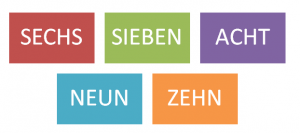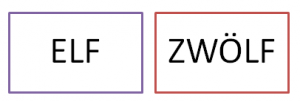The first 10 numbers
The biggest challenge with the first ten numbers will most likely be pronunciation. Find sources on the internet to hear how they are pronounced – one is provided below.


Elf for eleven and zwölf for twelve are still two single words – and clear cognates of the English ones. After these single digits, a pattern evolves:
DREI + ZEHN (dreizehn)
VIER + ZEHN (vierzehn)
FÜNF + ZEHN (fünfzehn)
SECHS + ZEHN (sechszehn)
SIEB + ZEHN (note a slight deviation from the pattern here)
ACHT + ZEHN (achtzehn)
NEUN + ZEHN (neunzehn) and then comes

Little note on the side: When written out, the two words are spelled together, but mostly numbers above nine are written in numerals.
These patterns still resemble English. But then things change a little; how do we say e.g. 21, 33, 47, 59, 84, 96 in German? Try to figure out, which numbers match which written forms and then describe the pattern.
| 1. dreiunddreissig | a) 59 |
| 2. siebenundvierzig | b) 84 |
| 3. einundzwanzig | c) 33 |
| 4. neunundfünfzig | d) 21 |
| 5. vierundachtzig | e) 55 |
| 6. dreiundsechzig | f) 24 |
| 7. einundsiebzig | g) 71 |
| 8. neunundzwanzig | h) 92 |
| 9. zweiundneunzig | i) 29 |
| 10. achtunddreisssig | j) 63 |
| 11. vierundzwanzig | k) 47 |
| 12. fünfundfünfzig | l) 38 |

![]()
Answers: 1c 2k 3d 4a 5b 6j 7g 81 9h 10l 11f 12e
Listen to how the numbers are pronounced on Easy German Counting in German from 1 – 100 | Super Easy German.The numbers are gradually introduced and spoken slowly. The speaker starts with 1-10 and moves on to 100.
More sources for practicing:
Practice with
German Numbers Flashcards | Quizlet
German numbers 11 to 20 Flashcards | Quizlet
Go to DW What goes together? | 14 Numbers
Numbers can always be practiced on the side. Add arithmetic functions and you can play little counting games.
Advanced challenge:
In English, we have the words NUMBERS and FIGURES; in German we have ZAHLEN, ZIFFERN and NUMMERN. What are the differences?
One good source for research is Cambridge dictionary: Nummer | translate German to English – Cambridge Dictionary; Glosbe also provides many examples.
Note: You will encounter the German word Nummer in various contexts with various different meanings. Don’t despair and don’t try to learn all these meanings outside a context of use. Just take note of their existence. If you want to learn them to at least be able to recognize them when you see or hear them, create a flashcard set. It could be an interesting theoretical linguistic exercise to analyze them to figure out which meanings are related (polysemes), which ones seem to be completely different (homonyms) and which ones metaphorical meaning transfers.
Create a word field around the topic of numbers.
